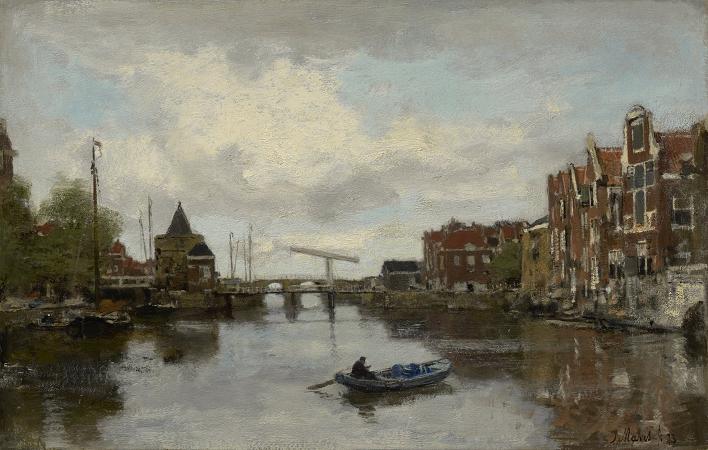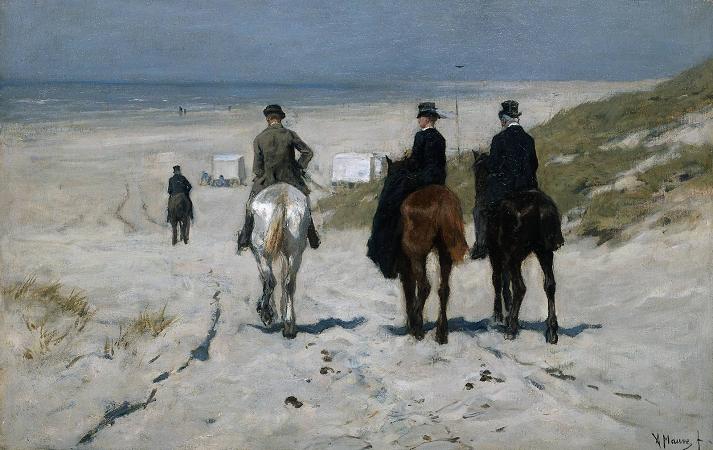Hague School Artist. The Hague School is a group of artists who lived and worked in The Hague between 1860 and 1890. Their work was heavily influenced by the realist painters of the French Barbizon school. The painters of the Hague school generally made use of relatively somber colors, which is why the Hague School is sometimes called the Gray School. After the great periods of Dutch art in the Golden Age of the 17th century, there were economic and political problems which diminished activity in art. The fine arts in the Netherlands enjoyed a revival around 1830, a time now referred to as the Romantic period in Dutch painting. The style was an imitation of the great 17th-century artists. The most widely accepted paintings of this period were landscapes and paintings which reflected national history. Andreas Schelfhout was a painter of landscapes, especially winter scenes, but also woodlands and the dunes between The Hague and Scheveningen. His best known pupils included Wijnand Nuyen, Johan Barthold Jongkind, and Jan Hendrik Weissenbruch. Schelfhout's friend and occasional collaborator Hendrik van de Sande Bakhuyzen principally composed pastoral landscapes like those of Golden Age master Paulus Potter, but trained several prominent Hague School artists, notably his son Julius van de Sande Bakhuyzen, Willem Roelofs, Francois Pieter ter Meulen, Hubertus van Hove, and Weissenbruch. Wijnand Nuyen was one of the best of the romantic artists of the time and he had a great influence on Weissenbruch and Johannes Bosboom. Art training at that time was usually in the form of drawing schools, with no painting classes. Many young artists who later became members of the Hague School were frustrated by this and scattered to various places to receive the training they desired. Gerard Bilders left the Hague Academy of Drawing and completed training with the Swiss animal painter, Charles Humbert. Paul Gabriel went to Kleve, just over the German border, to study with the landscape painter Barend Cornelis Koekkoek. Jozef Israels, unsatisfied with the academies at Groningen and Amsterdam, left for Paris to attend classes at the studio of Francois-Edouard Picot. Jacob Maris left the Hague Academy for the corresponding institution in Antwerp and from there he went to study with Ernest Hebert in Paris. His brother Matthijs Maris studied with Nicaise de Keyser in Antwerp. Hendrik Willem Mesdag left Groningen to perfect his skills in Brussels under Willem Roelofs. He also received additional instructions from Lawrence Alma-Tadema, who would later move to England. In the 1830s artists like Theodore Rousseau, Jean-Franccois Millet, Charles-Francois Daubigny, and Jean-Baptiste-Camille Corot found their way to Barbizon, a forested area near Fontainebleau. The emphasis of their work here was on painting nature as they saw it-Barbizon was not a school but a community of artists. This gave rise to the well known Barbizon school and their example was followed in the 1850s by a few Dutch painters who gathered in Oosterbeek in order to work in the surrounding countryside. These painters had been influenced by the artists of the Barbizon School and emulated them by registering their impressions with rapid strokes of color. Johannes Warnardus Bilders, father of Gerard Bilders, moved to Oosterbeek in 1852 and attracted many pupils: Anton Mauve, a cousin-in-law of Vincent van Gogh, the Maris brothers in the summer, as well as the regular visitors Willem Roelofs and Paul Gabriel. Some of these artists, such as Jozef Israels, Jacob Maris and Jan Hendrik Weissenbruch visited Barbizon to paint there. There was a slight connection between the Dusseldorf Art Association when an exhibition on Fishing in Scheveningen occurred. It concerned such artists as Carl Hilgers, Hermann Mevius, Carl Adloff and Andreas Achenbach. The call of the Dusseldorf painters' school attracted artists of the Hague school, such Johannes Bosboom and J. W. Bilders. At the beginning of his career Jozef Israels went on a study trip to Dusseldorf. Also Julius van de Sande Bakhuyzen and Philip Sadee came to Dusseldorf. The Dusseldorf academy was famous as a training center for her scenery and histories painting. The bright colour order which distinguishes those paintings is unmistakable. Gerard Bilders had been seeking something of the kind in his own work, but on visiting the national Exhibition in Brussels in 1860, he found what he had been looking for: a colored gray tonality, or as he put it the impression of a warm, fragrant gray. The muted tones and warm gray that Bilders found here was certainly discussed with his friends in Oosterbeek and found its way into the work of the young Hague School painters.
more...











